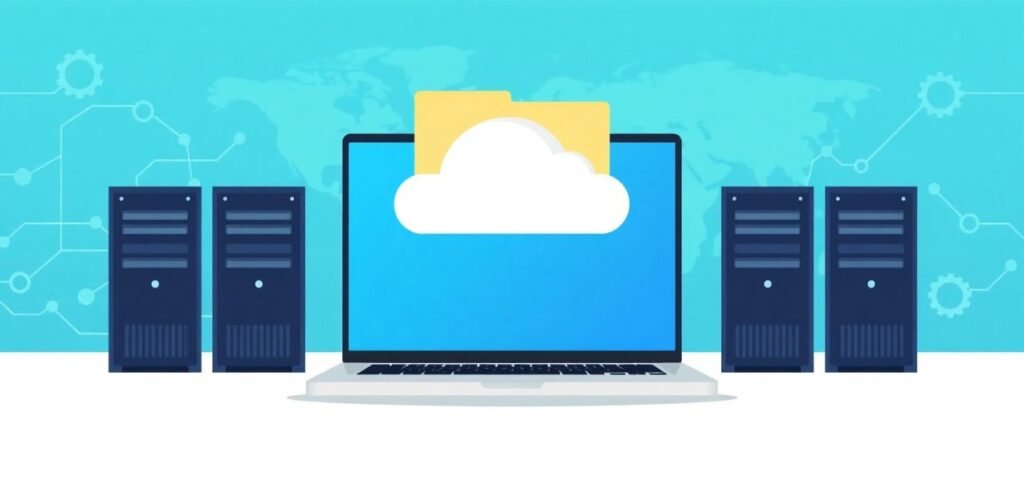In today’s digital world, cloud computing plays a big role in how businesses run their operations. You’ve probably heard about the cloud, but have you come across the term hybrid cloud computing? If you’re wondering what it means and how it works, you’re in the right place.
Let’s break it down in simple words.

What is Hybrid Cloud Computing?
Hybrid cloud computing is a type of IT setup that combines two different kinds of cloud environments:
- The public cloud is provided by third-party suppliers who include Amazon Web Services (AWS), Microsoft Azure and Google Cloud. Multiple users enjoy access to it because the cloud serves as data storage and hosts websites and runs applications.
- Many organizations use private cloud solutions for their computing needs since the system serves one specific organization exclusively. The deployment method for hybrid clouds happens on the company’s servers or through collaboration with a cloud service provider. This solution offers enhanced protection and complete data management control to the company.
A hybrid cloud system enables companies to combine public and private clouds into one unified operational unit.
Why Use a Hybrid Cloud?
The main reason companies use hybrid cloud computing is to get the best of both worlds. Here’s why:
- Organizations maintain full authority to determine the location of their workload execution. Companies benefit from running their sensitive tasks within private cloud infrastructure while operating less sensitive applications through public cloud systems.
- Users obtain cost efficiency through public clouds since they effectively split their resource expenses. Businesses lower their expenses by performing heavy operations on the public cloud that do not need additional security measures.
- Companies who need additional computing power can scale up by entering the public cloud for “bursting” needs instead of acquiring new hardware.
- The private cloud enables companies to store sensitive information for compliance needs but they can access the agility and capacity of public clouds.
How Does Hybrid Cloud Work?
Now that we know what it is, let’s talk about how it works.
A hybrid cloud setup connects a private cloud with a public cloud. This connection can be made in a few different ways:
- The combination of secure network infrastructure includes VPNs (Virtual Private Networks) and dedicated lines as methods to link two cloud environments.
- Effective data and application management between the public and private clouds is possible through orchestration tools connected to software.
The objective aims to establish a seamless network between the public and private cloud environments which operate like an unified system.
Here’s an example to make it clearer:
Imagine a retail company. It runs its customer database (which is sensitive) on a private cloud. But during a big sale, it expects a huge spike in website traffic. So, it temporarily shifts some of its web services to a public cloud to handle the extra load. Once the sale is over, it moves everything back. That’s hybrid cloud in action.
Real-Life Uses of Hybrid Cloud
Many industries use hybrid clouds. Here are a few examples:
- Patient data resides within private clouds at healthcare facilities because of security requirements although appointment scheduling and emailing systems operate through public clouds.
- Bank accounts maintained in private clouds by institutions while they utilize both public clouds to support mobile applications along with marketing solutions.
- The implementation of private clouds serves inventory management needs while public clouds process user traffic during online sales events. (Hybrid cloud computing)
Is Hybrid Cloud Right for Everyone?
Not every company needs a hybrid cloud. It works best for businesses that:
- The organization needs to strictly adhere to existing data privacy regulations.
- Have unpredictable workloads or traffic
- The organizations desire maximum administrative freedom for their systems together with adaptable data management capabilities.
The dual environment management demands adequate preparation as well as suitable administrative instruments to operate both domains effectively. (Hybrid cloud computing)
Final Thoughts
Hybrid cloud computing is becoming more popular because it gives businesses the freedom to choose the best place for each of their workloads. It’s all about balance — combining the control and security of a private cloud with the power and cost savings of a public cloud.
Whether you’re a small startup or a large enterprise, understanding how hybrid cloud works can help you make better tech decisions and build a stronger, more flexible IT system. (Hybrid cloud computing)
